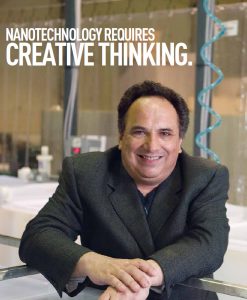Article from Skulematters, Spring 2008 by Christine Ward

When it comes to nanotechnology research, Dr. Gino Palumbo has a simple philosophy: the crazier the better. The President and co-founder of Integran Technologies Inc. has valuable experience to back his thinking; the self described “pie-in-the-sky” research he completed during his PhD studies in U of T’s Engineering Faculty just translated into several major R&D contracts with the U.S. Air Force and NASA. “The technology had been sitting on the shelf for years,” he laughs. “At the time, I thought it had no practical application whatsoever.”
A three-time U of T Engineering grad (MMS 8T3, MASc 8T5, PhD 8T9), Palumbo spent the better part of the 1980s analyzing and testing the properties of materials in the hopes of better controlling elements that impact performance — like strength, hardness and resistance to corrosion. Only recently have the potential benefits of the technology for jet engine components been recognized.
“By changing the internal structure of engines’ materials, we can potentially increase performance and durability, and decrease overhaul and repair costs,” he says.
The Air Force and NASA contracts are just the latest in a string of research wins for Palumbo and Toronto-based Integran, a leading supplier of nanotechnology-enabled metallurgical products and processes. The company holds one of the first U.S. patents issued in nanotechnology. It’s also among the first in the world to develop a large-scale industrial application for nano-materials: the Electrosleeve™ process for repairing nuclear reactors was conceived in the early 1990s while Palumbo was at Ontario Hydro and with help from Professor Doug Perovic (MMS 8T6, MASc 8T8, PhD 9T0) and Professor Uwe Erb, Palumbo’s former research colleague, now both faculty members here in the Department of Materials Science & Engineering at U of T. More than $12 million was spent developing the technology over two years, making it one of Canada’s then-largest research and development efforts.
“This is exactly why we maintain such close ties with U of T,” says Palumbo. “It’s the only place and time in which you can think completely outside-the-box. We’re all at our most creative during our university years.”
“It just goes to show that some of the craziest pursuits can pay off in the long run,” says Palumbo.
To this day, Palumbo remains a big fan of U of T’s Materials Science and Engineering department. A full one-quarter of Integran’s 50 Canadian employees (another 50 or more are employed at four spin-off companies throughout the U.S. and a production facility in Mexico) are U of T alumni; a handful of projects are underway in collaboration with Erb, Perovic, Professor Glenn Hibbard (MSE PhD 0T2) and Palumbo’s former PhD supervisor, Professor Emeritus Karl Aust (MMS 4T6, MASc 4T8, PhD 5T0); and the company has a steady stream of undergraduate students completing their Professional Experience Year (PEY).
It all adds up to a culture ripe for discovery. In 2007, Integran was recognized as Innovative Business of the Year by the Canadian Manufacturers & Exporters Association, an honour Palumbo credits in large part to his alma mater.
“This is exactly why we maintain such close ties with U of T,” says Palumbo. “It’s the only place and time in which you can think completely outside-the-box. We’re all at our most creative during our university years.”
“Taking advantage of that is something Integran has done reasonably well.”